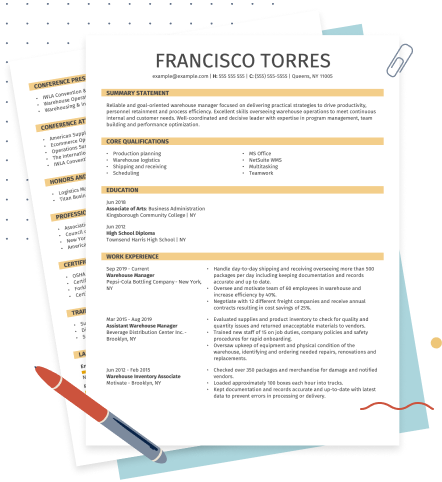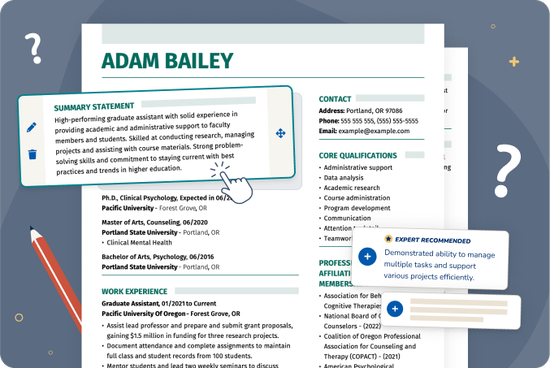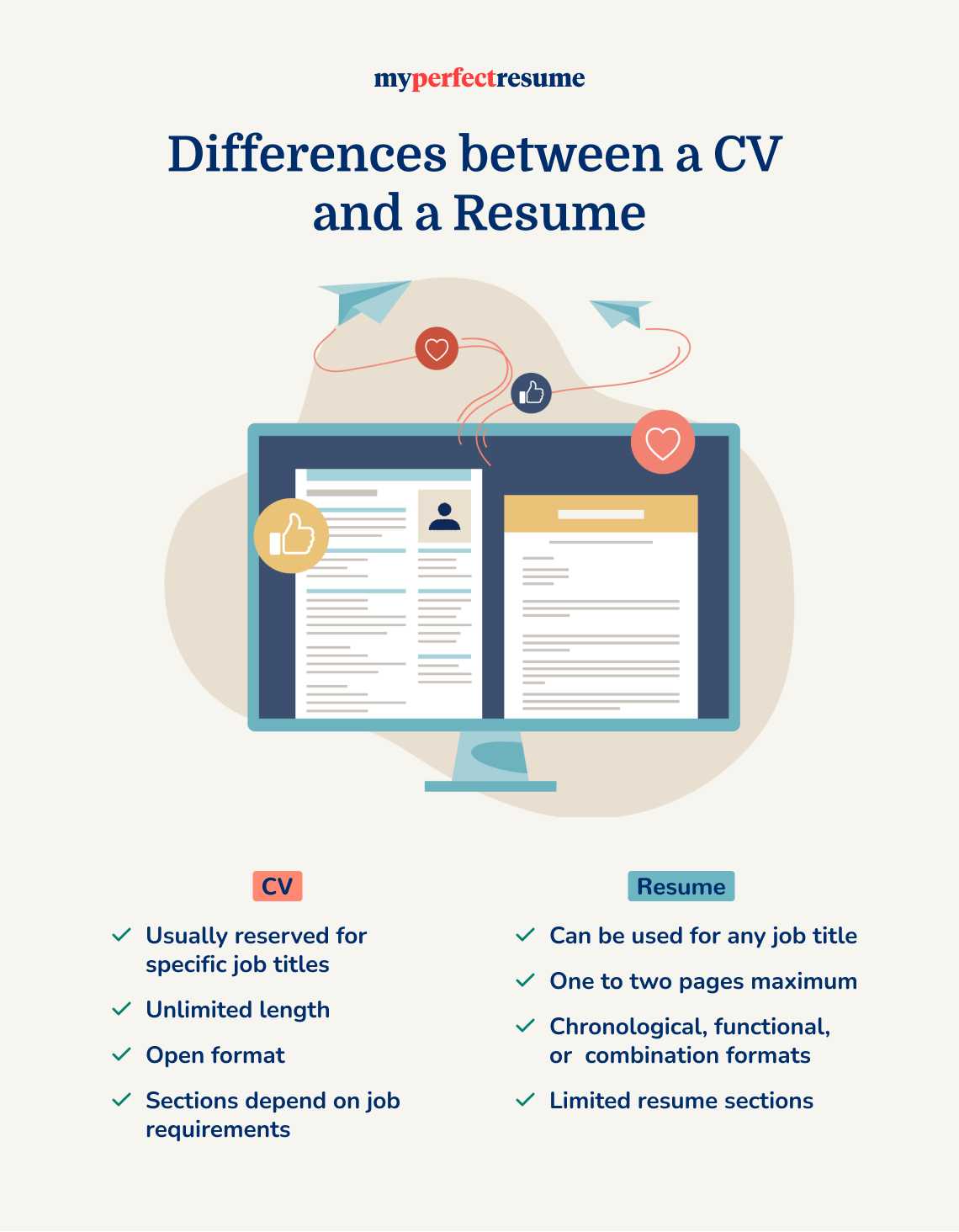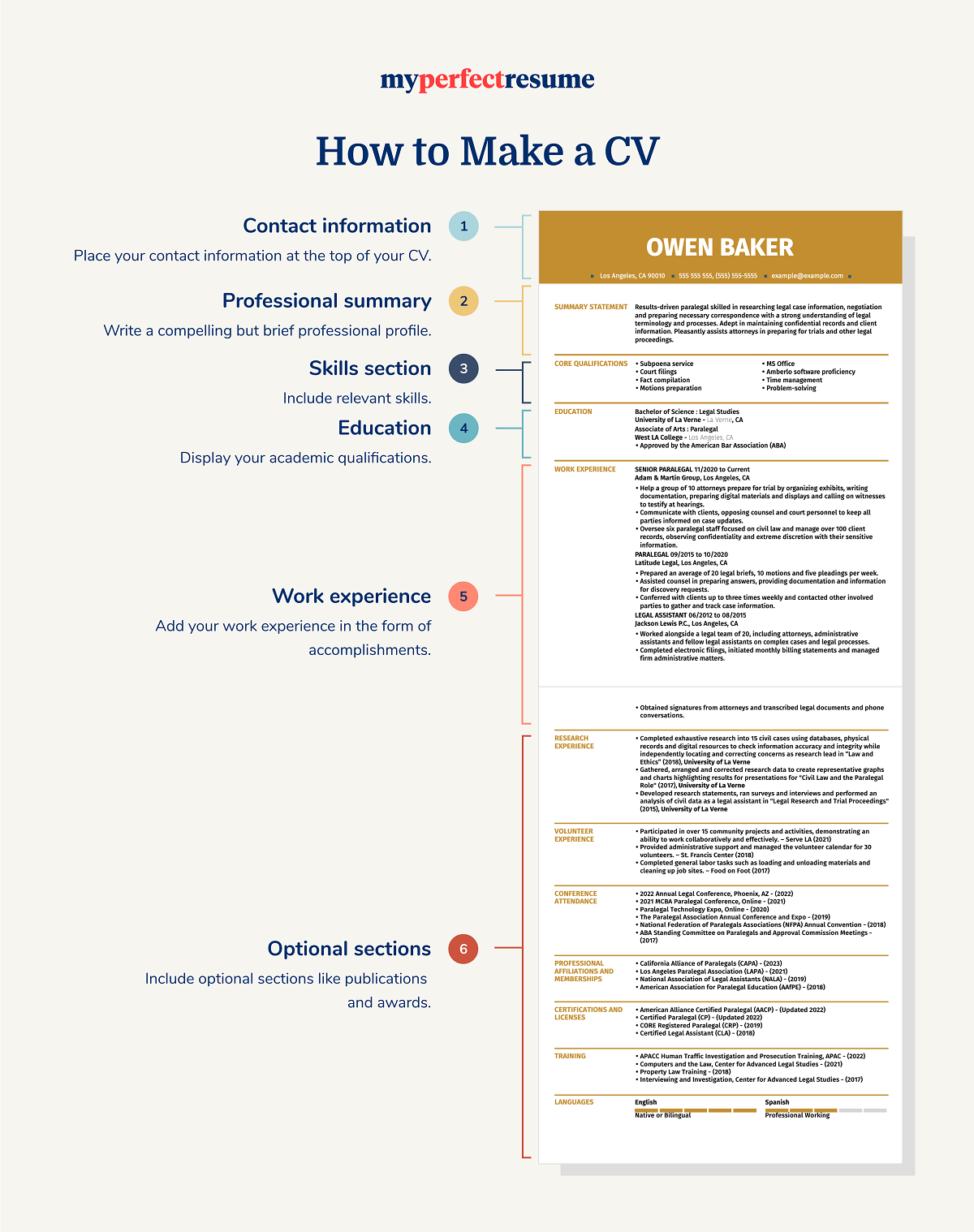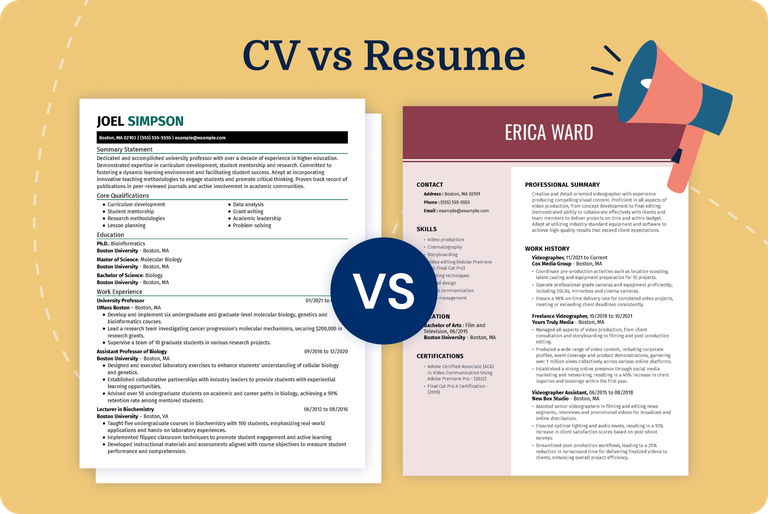Our customers have been hired at: *Foot Note
A CV, short for curriculum vitae, which is Latin for “course of life,” is a detailed account of your professional experience and academic background.
This guide covers the fundamentals of CV writing, offering expertly crafted examples and tips on using our CV Maker to build a CV from any device. We’ll explore key topics, including:
- The purpose of a curriculum vitae.
- How a CV is different from a resume.
- How to write a CV, section by section.
- How to format and structure a CV.
What Is the Purpose of a Curriculum Vitae?
A curriculum vitae (CV) is a comprehensive document that outlines your professional and academic history, skills, accomplishments and other relevant experiences.
A CV provides a detailed overview of your qualifications and measurable achievements to potential employers or other organizations.
Here are a few examples of the primary uses for a CV:
- Job Applications: A CV is often required when applying for academic, research or high-level professional positions.
- Academic and Research Positions: A CV is essential when applying for academic positions such as faculty roles, research positions or graduate programs.
- Grant and Fellowship Applications: A CV is also used when applying for grants, scholarships or fellowships, where you need to demonstrate your qualifications.
- Professional Networking: A well-crafted CV can showcase your expertise when shared with colleagues, mentors or other professionals in your field.
- Career Advancement: A CV can be used as a tool for career planning and advancement, allowing you to track your professional growth and set career goals.
Explore our library of 300+ professional CV examples to see expertly crafted CVs for various roles, industries and career stages.
How Is a CV Different From a Resume?
A CV is a detailed, career-long document used mainly in academic and research settings, while a resume is a concise, targeted document used for most nonacademic job applications.
Below are some of the key differences between CVs and resumes. For additional details, we recommend exploring our CV vs. Resume guide.
- Length: Resumes are usually one to two pages long and focus on the most relevant work experience and skills for the specific job you're applying for. CVs are typically longer and provide a more comprehensive overview of your background.
- Purpose: A CV is primarily used in academic, research and scientific fields, whereas a resume is used for job applications in most other industries, such as business, marketing, technology and nonacademic sectors.
- Content: CVs include detailed information on your academic and professional background, including research experience, publications and presentations. Resumes include professional experience, education and skills tailored to the specific job.
- Customization: A CV is often static and does not change significantly between applications. A highly customizable resume should be tailored for each job application to highlight the most relevant experience and skills for the position.
- Location: In most European countries, job seekers use a CV instead of a resume. A U.S. resume is for U.S. job applications outside of academia, while a CV is reserved for academic, research or international job applications.
How to Write a CV for a Job Application
Writing a CV involves compiling a detailed and organized document that showcases your academic, professional and personal achievements.
Follow our step-by-step guide to learn how to make a CV that sets you apart from the competition and boosts your chances of landing an interview.
Step 1
Gather your information
Preparation is critical to writing a standout CV. Having your essential information ready will ensure you customize your CV for your desired job.
Scan the job description for keywords to incorporate into your CV. This ensures that your application passes automated screening and reaches hiring managers.
Make a note of all the requirements and “nice-to-haves” from the job description. Then, make a list of the following information:
- Education Details: Institutions attended, degrees earned, honors, awards and thesis or dissertation titles.
- Professional Experience: Job titles, company and institution names, locations, dates of employment, responsibilities and key achievements.
- Publications and Presentations: Titles of papers, names of journals or conferences or presentation dates.
- Skills: Software proficiency, languages, soft skills and technical skills relevant to your field.
- Research Experience: Research Experience: Relevant project titles, institutions, dates and important contributions or skills gained.
- Certifications and Licenses: Relevant certifications or licenses and the dates they were obtained.
- Professional Affiliations: Memberships in professional organizations or societies relevant to the field.
- Awards and Honors: Scholarships, grants, fellowships and any other significant recognitions.
Step 2
Choose a professional CV template
There is no set CV format for job applications, so you can organize your professional qualifications based on your industry, job title and the position's requirements.
That said, a CV template is the best way to structure your curriculum vitae so it passes the applicant tracking systems (ATS). Explore our ATS-friendly resume guide for additional tips.
Our expertly crafted CV templates organize the sections of your CV for maximum readability and allow you to update an existing CV for quick customization and optimization.
Professional templates ensure your CV is formatted correctly with 1-inch spacing and margins, professional fonts and a visually appealing design.
Choose one of the CV templates below and use our CV Maker to add your professional details and expert content suggestions.
Step 3
Add your contact information
No matter how you format your CV for a job, remember to include your contact information at the top of your document so that hiring managers can easily find you.
You can format your CV header the same way that you would format your resume header. Remember to include the following information:
- Your full name.
- Phone number.
- Professional email address.
- City and ZIP code.
- A link to your LinkedIn account, website or portfolio.
Step 4
Include a professional summary
We recommend adding a professional summary to your CV to quickly introduce yourself and offer employers a glimpse into your work experience and relevant skills.
Here’s an example CV summary statement to get you started:
Skilled assistant attorney in private practice with over five years of experience settling personal injury cases and litigating employment defense. Specializes in negotiating settlements quickly. Excels at using research and analysis to provide clients with optimal strategies for the best outcomes. Experienced in preparing discovery, writing case briefs and peacefully resolving negotiation conflicts.
From there, you can put your CV sections in the order that best highlights your qualifications for the job, as long as you include skills, education and work experience.
Step 5
Showcase relevant skills
Placing your CV skills section directly under your summary helps potential employers find your core qualifications quickly when they scan your CV for relevance.
You can use our AI-powered skills generator tool to start brainstorming job-relevant skills to include on your CV.
AI Resume Skills Generator

You can stand out by displaying five to 10 of your most job-relevant hard skills and soft skills on your curriculum vitae. Here are some of the best skills to include on your CV:
- Resilience
- Communication
- Interpersonal skills
- Leadership
- Adaptability
- Flexibility
- Collaboration
- Active listening
- Cultural competence
- Creativity
Step 6
Add your work experience
Work history is an essential part of any job application CV. It’s best to place your professional experience section in the first quarter of your CV so potential employers can easily find it.
List current and past jobs in reverse-chronological order, starting with your most recent position. Reference the chronological resume format for additional tips and examples.
Showcase three to five key accomplishments for each role to highlight what you contributed to previous employers and companies. In addition to accomplishments, include the following:
- Company names.
- Dates of employment.
- Job title.
Prospective employers look for numbers and figures that indicate the candidate’s positive contributions in past roles.
Notice how the work history entry example below for a physics professor CV highlights impact rather than simply listing job responsibilities.
WORK HISTORY
Adjunct Physics Professor
Drexel University, Department of Physics | Philadelphia, PA
September 2015 – Present
- Develop lab activities for 25 students in three different undergraduate physics classes ranging from beginner to intermediate.
- Guide 15 third-year students through thesis development and research opportunities.
- Created five lab manuals for Physics 101, 102 and 201.
- Led 20 undergraduate students in an award-winning research study on modern advances in radiation therapy.
Use powerful action verbs throughout your CV to emphasize your impact in past roles. Explore the examples below for inspiration.
- Mediate
- Articulate
- Interface
- Convince
- Negotiate
- Critique
- Arbitrate
- Counsel
- Motivate
- Mentor
- Collaborate
- Resolve
- Inspire
- Encourage
- Listen
- Assist
- Help
- Relate
- Interpret
- Liaise
- Translate
- Guide
- Interact
- Express
- Correspond
- Determine
- Evaluate
- Formulate
- Interpret
- Measure
- Predict
- Survey
- Establish
- Optimize
- Summarize
- Examine
Step 7
Create your education section
Like the skills and work history sections, you can present the education section of your CV in any order on your resume, depending on your experience level and field of study.
For example, suppose you are a medical doctor with several years of experience. In that case, you might place your CV education section after your skills and education sections.
Whereas if you are applying for your first postgraduate assistant professor position, it makes more sense to show your education credentials before anything else.
Display the name of the school or institution, the degree you earned and the date you graduated.
See how to list education on a resume, for sample education sections and tips from career advice experts.
If you have multiple degrees or studied at more than one institution, list them in reverse-chronological order, with the most recent school first.
Provide your GPA if it was 4.0 or higher, and note academic honors, awards, grants, scholarships or fellowships. Here’s an example education section for a corporate lawyer CV:
EDUCATION
Juris Doctorate | University of California, Berkeley | Berkeley, CA
Master of Business Administration | Northwestern University | Chicago, Illinois
Bachelor of Arts in English | University of Arizona | Tucson, Arizona
Step 8
Add optional CV sections
You can add additional sections to your curriculum vitae to demonstrate the breadth of your experience and qualifications. Explore a few examples below to get started.
Certifications
Not all professions require certificates or licenses, but if you have them, create a certifications section on your CV and list them in reverse-chronological order from the date you received them.
CERTIFICATIONS
Notary Public, Michigan
Michigan Department of State.
Issued May 2021
Renewal date: May 2023
Awards and Honors
When writing a CV, you can add a section showcasing the awards you have received throughout your education and career.
This section should include dean’s list recognitions, academic or professional distinctions, leadership and volunteer or community awards.
List awards and honors in reverse-chronological order, formatted with bullets, and include the name of the award, issuing organization and date you received the award, like this example:
AWARDS & HONORS
- Heroes of Chemistry Award, American Chemical Society, 2023
- National Academy of Sciences Award in Chemical Sciences, National Academy of Sciences, 2020
- Peter Debye Award in Physical Chemistry, American Chemical Society, 2018
Publications
If you have published articles, research papers, essays, stories or books, showcase them in a separate section of your CV — they can help you stand out!
List your publications in reverse-chronological order and let them shine in a bulleted list. Include the title of the work, the publication name and the publication date.
Here’s an example of how to create a CV publications section:
PUBLICATIONS
Smith, J., & Johnson, L. (2023). Advancements in CRISPR-Cas9 Technology. Nature Biotechnology, 41(3), 456-462.
- Explored the latest innovations in CRISPR technology and its applications in genetic engineering.
Volunteer Experience
Hiring managers like to see volunteer experience on a curriculum vitae because it shows you are well-rounded, have strong interpersonal skills and are willing to go the extra mile.
When writing a CV volunteer experience section, add the most recent experience first, your volunteer title, the name and location of the organization and the date you volunteered.
VOLUNTEER EXPERIENCE
Attending physician, World Pediatric Project
Guatemala City, Guatemala | 2022
Lead Clinician, Clinic by the Bay
San Francisco, CA | 2019
See how to discuss volunteer work on a cover letter for additional guidance on showcasing a range of relevant experiences.
Step 9
Proofread and revise your CV
Proofread your CV for a job application more than once, and have a trusted friend or family member review it and make necessary revisions before sending it to a potential employer.
Bulletproof your curriculum vitae by ensuring it is formatted correctly and includes the correct information in each section.
We recommend using our ATS Resume Checker, which will scan your CV for common errors and offer instant suggestions for improving the structure and content.
Step 10
Save and download your CV
A polished job application CV means you must also name your document professionally and save it in an appropriate file format.
We recommend the following formula to name your file: “Your Name-Job Title-CV-Company Name-Date”
Saving your document as a Word file is a safe bet if a specific file type is not requested in the job description because most ATS can read Microsoft Word files, and most companies prefer them.
Saving your file as a PDF is also a good option to ensure formatting consistency across different devices and platforms.
Put your name at the front of your CV file name. This makes it easy for hiring managers to remember you when sorting through hundreds of CVs for a job application.
CV Formatting Tips
- Keep it clean and professional: Use a professional and easy-to-read font, such as Arial, Calibri or Times New Roman. A font size of 10-12 points is typically ideal.
- Use clear headings and subheadings: Use bold or slightly larger text for section headings to organize the content and make it easier for the reader to navigate.
- Incorporate bullet points for easy reading: Use bullet points to break down your roles, responsibilities and achievements in each section.
- Use consistent spacing: Align text to the left, as it’s easier to read. Avoid justified text, which can create uneven spacing. Use consistent spacing between sections and entries.
- Set margins strategically: Use 1-inch margins on all sides of the page. If you need more space, you can reduce the margins slightly but don't go lower than 0.5 inches.
- Use white space: Your CV should be visually appealing and easy to read, so don’t overcrowd it. Leave plenty of white space.
- Avoid overuse of graphics and colors: Stick to a clean, professional look. Avoid using excessive colors, graphics or overly creative layouts.
More CV Examples
Refer to the CV examples below for guidance as you write your CV. Our samples are professionally crafted to showcase job-relevant skills and experiences.
CV Writing Tips
Here are some key tips to consider when writing a CV to ensure it effectively showcases your qualifications and experiences:
- Tailor your CV to the job: Customize your CV for each job application. Highlight the skills, experiences and achievements that are most relevant to the specific role.
- Focus on achievements: Rather than just listing your responsibilities, focus on what you achieved in each role. For example, “Published five peer-reviewed articles.”
- Use action verbs: To convey impact, start bullet points with strong action verbs like "developed," "managed," "designed," "led," "implemented" and "achieved."
- Highlight relevant skills: Include a skills section where you list specific competencies relevant to the job. These might include language skills or any specialized knowledge.
- Include keywords: Review the job description and incorporate relevant keywords into your CV. Many companies use applicant tracking systems (ATS) that scan for these.
- Keep it professional: Avoid informal language, personal pronouns (e.g., "I," "me"), and unnecessary details like hobbies or unrelated interests unless they add value.
- Showcase continuous learning: Include relevant courses or professional development activities demonstrating your commitment to your field.
Mistakes to Avoid
- Including irrelevant information: Avoid listing every job you’ve ever had or unrelated hobbies and interests.
- Focusing on duties instead of achievements: Rather than listing job duties, highlight your accomplishments and the impact you made in each role.
- Spelling and grammar errors: Typos and grammatical mistakes can make you seem unprofessional. Always proofread your CV carefully to check for these errors.
- Including personal information: Don’t include personal details such as your age, marital status, religion or a photo unless it’s specifically requested.
- Not highlighting career progression: If you’ve advanced in your career, make sure to show how your roles have developed over time.
- Neglecting to update your CV: Regularly update your CV to reflect your latest experience, skills and achievements.
Write a Cover Letter to Complement Your CV
Increase your chances of securing your next job interview by including a compelling cover letter with your CV.
Cover letters are vital to job applications because they show potential employers the person behind the job qualifications.
They allow you to tell employers why you are interested in the job and why you’re the best match for them. Plus, they let you explain employment gaps and career changes.
Key Takeaways
- The best way to prepare for writing a CV is to collect critical information, such as relevant skills and measurable achievements from your career.
- Include keywords and phrases from the job description throughout your CV.
- Use a professionally designed CV template and CV Maker to build a polished CV in minutes.
- Download a CV example that matches your industry for inspiration.
- Always pair a complementary cover letter with your curriculum vitae.
FAQ
How do I write a CV with no experience?
Here are a few tips if you are crafting a student CV or writing a professional CV with minimal work experience:
- Write a professional summary that draws hiring managers with confidence and enthusiasm.
- Follow your professional profile with an education section emphasizing academic awards, grants, scholarships and honors.
- Create an impressive skills section focused on transferable skills, which are soft skills that can be applied to any job and industry.
- Add community service or volunteer activities that show you have the know-how to perform the work.
Check out our ChatGPT CV guide for tips and precautions on using AI to support the CV writing process.
How do you tailor a CV for a specific job?
To tailor a CV for a specific job, carefully review the job description and requirements to identify keywords.
Customize your CV by highlighting relevant skills, experiences and achievements that align with the job.
Adjust the order of sections or include additional sections to emphasize your suitability for the role.
Why should I use a professional CV template?
Good CV templates save time and effectively allow you to write a professional CV.
Our layouts are preformatted, so you can be confident your CV for a job application is formatted correctly to get past ATS.
We also recommend exploring our library of resume templates if you plan to create a resume for any of your job applications.
How do I customize my CV template?
It’s easy to customize a CV template with a few clicks using our CV Maker.
We’ll ask you a few questions for each section and provide industry-specific, expert-written suggestions for tailoring your curriculum vitae.
You can edit every section of your CV as you go and even after you save it.
What should I include in my CV?
A CV should include your contact information, educational background, work experience (including internships or part-time jobs), skills, achievements, certifications and other relevant information that showcases your qualifications for the desired position.
How long should my CV be?
How long you make a CV depends on your work experience, your industry and how many professional qualifications you want to show to get the job. That’s why a CV can range in length between two to six pages.
Explore our resume length guide if you choose to write a resume rather than a CV for any of your job applications.
How do you format a CV?
Format your CV in a clear and organized manner. Use headings and subheadings to separate different sections, and choose a professional font and font size.
Ensure consistency in formatting, such as bullet points for listing information and a consistent date format.
Our customers have been hired at:*Foot Note

